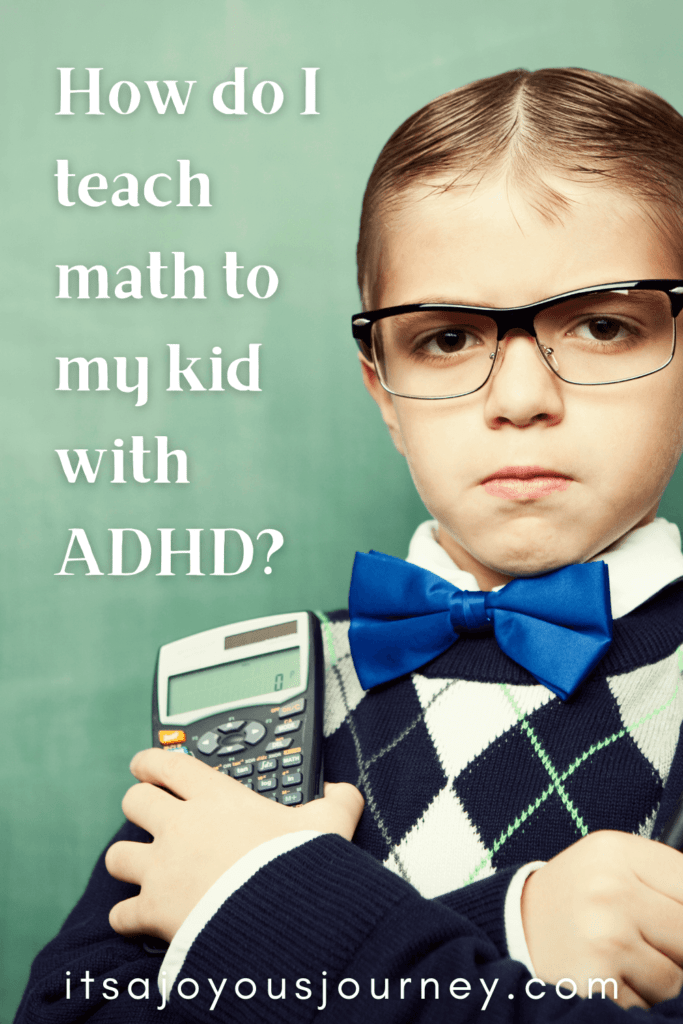Homeschooling with ADHD? These 7 tips for how to teach math will boost your confidence as a teacher and ease the math stress in your homeschool.
It’s A Joyous Journey LLC was compensated for writing this review. All opinions are honest and based on our own experiences and/or research of the brand we are promoting. Links within this post may contain affiliate links for which we would earn commission, at no additional cost to you, should you choose to purchase products through our links. We take no responsibility for content on any external links. Please see our Disclosure Policy for more information.
Pin for Later…

One of the most common questions that is asked in my ADHD Homeschooling Support Group is, “How do I teach math to my child with ADHD?” It can be tough, for sure!
One of the hallmark attributes of attention-deficit/hyperactivity disorder (ADHD) is a lack of executive functioning skills, such as:
- Working memory
- Self-regulation
- Organization and planning
- Transitioning from one task to another
- Initiating and completing tasks
- Impulse control
- Prioritizing tasks
- Flexible thinking (understanding different strategies or viewpoints)
Many of these skills are critical for understanding and implementing mathematical concepts. Add to these any number of other symptoms that are common on the ADHD spectrum, and it’s not surprising that math is often a challenge for homeschooling families when ADHD is a factor.
These 7 tips for how to teach math will help ease the math stress in your homeschool and give both you and your child a boost of confidence.
Tip #1-Connect Math to Everyday Life
ADHD has always been labeled as an attention deficiency disorder. I mean, it’s in the name, right? Recently, however, it’s starting to be reframed as not so much a lack of attention as it is a need for attention stimulation.
In other words, people with ADHD are hardwired to focus their attention on things that are interesting to them. That’s why they can hyperfocus on something that interests them for hours but legitimately can’t concentrate on something that is boring to them for any sustained length of time.
In fact, Dr. Edward Hallowell and Dr. John Ratey, two well-known ADHD researchers have coined a new term called Variable Attention Stimulus Trait (VAST) to better define what is really going on in the ADHD brain.
Understanding this trait helps us to better recognize the need to connect our child’s learning to everyday life. They have to have a vested interest in it before their brain will allow itself to put energy into focusing its attention on it.
Math in Real Life
In the younger years, it’s a little easier to come up with ways to connect math to everyday life. Cooking meals, trips to the grocery store, saving money for a desired purchase, and time management are all obvious situations where we use math in our daily life.
When our kids get into upper-level math, it becomes a little more difficult to identify specific real-life scenarios for all of those equations and proofs. There are ways to really make it fun, though!
Let them re-paint their bedroom, for example. Figuring out how much paint to buy, finding the best deal for your budget, and getting the job done on a deadline will show them just how much all those algebra and geometry skills are used in real life!
So, while it may take some more effort on our part as our kids get into middle and high school, connecting math to everyday life will help them stay engaged and give them a reason to allocate some of their attention to learning it.

Tip #2-Choose a Math Curriculum that Supports Your Child’s Learning Style Preferences
We already talked about how your child needs to be interested in something to give it sustained attention. Keep this in mind as you choose a math curriculum.
Online Math Learning
Does your child learn well in an online format with video instruction and colorful animations? CTCMath (all levels) is a great choice! CTCMath is an online math program that offers short video lessons with clear and simple explanations. It includes online questions that automatically adapt in difficulty to the student’s needs, but you can also print out worksheets and lesson summaries for some offline practice. Plus, there are step-by-step solutions to every problem to help students identify their mistakes and learn how to correct them.
All of these features are super helpful for teaching math to kids with ADHD, as we’ll talk about in some of the other tips in this post. Visit CTCMath to get a 50% discount on the Homeschool Family membership that gives you access to all math levels for your whole family!
Hands-On Math Learning
Does your child need to hold and manipulate physical objects to really understand concepts? Math-U-See (all levels) uses hands-on manipulatives to teach mathematical concepts all the way into high school courses. Singapore Math (grades PK-8) uses the Concrete, Pictorial, Abstract (CPA) approach to help students develop a deep understanding of math by starting with physical objects and then connecting that experience to pictures and, finally, abstract concepts. And Apologia Math (grades 1-3) introduces math through connections to God’s creation with lots of hands-on activities.
Blended Video and Workbook Math Learning
Does your child prefer to have video instruction but then also have a physical workbook to refer back to with lesson summaries, notes, and sample problems? For your middle and high school students, Videotext Interactive might be a great fit. It was a game-changer for my daughter! You can read or watch my full review of VideoText Interactive for detailed information.
Homeschooling with ADHD Curriculum Guide
My Homeschooling with ADHD Curriculum Guide will provide you with many great options for math and all of your other homeschool curriculum needs.
Access all of my homeschooling with ADHD resources here!
Tip #3-Teach One Math Concept at a Time
Remember that list of executive functioning skills that are usually lacking for people who have ADHD?
Things like working memory, organization and planning, prioritizing tasks, and flexible thinking would be necessary for a child to learn more than one math concept at a time. Slower processing speeds are also often seen on the ADHD spectrum.
So, while it might make sense to a neurotypical person to go ahead and throw in an extra concept or two that seem to flow logically from the first, it might easily overwhelm a person with ADHD.
What happens then? A meltdown. A shutdown. A decrease in self-confidence. An aversion to math. It all adds up (pun intended) to a kid who feels like they are incapable of learning math when all they really needed was a change in the way it was presented.
Modify the Curriculum
Don’t be afraid to modify the curriculum to meet your child’s needs. If they connect well with the teaching style, but there are just too many concepts presented at one time, break the lessons up over a few days.
It’s okay if you don’t get to the end of the textbook. Most math curricula spend at least the first couple of months of a new level reviewing the end of the previous level anyway.
And, please, always remember that there is no such thing as “getting behind” in homeschooling. One of the best blessings of homeschooling our kids with ADHD is that we can let them go at their own pace. It’s so much more important that they really learn something than it is for them to be rushed through a curriculum just to say they finished it.
Your child will make a lot more progress learning one concept at a time than they will if you try to throw several concepts at them at once.
Tip #4-Keep Math Lessons Short
We talked earlier about the need for attention stimulation in those with ADHD. Well, I’ve only come across a few people in my life who get truly excited about math. It’s just not something that most people really have a passion for, right?
So, unless your child is one of the few who are gifted with a love for math, it’s not likely that they’ll be able to focus their attention on it for long periods of time. This goes for both the teaching part and the practicing part!
Not only do you need short instructional time, but you also need to limit the overall lesson time each day. This might mean decreasing the number of assigned problems (choose just evens or odds) or putting a time limit on math each day. *Pro-tip: This helps for every subject…not just math.
If your child with ADHD were in a traditional educational setting, they would receive modifications and accommodations to help them succeed. Those modifications and accommodations are still necessary in a homeschool setting, so don’t let the comparison thief sneak in and convince you that you have to do things just like other homeschool families.
You’re homeschooling so you can meet the individual needs of your children. It’s okay if that looks different for your family than it does for others.
Tip #5-Don’t Depend on Math Memorization
Let’s talk about working memory…
I used to really not understand when my kids with ADHD told me that they couldn’t remember something that we had just talked about (or something that we had talked about over and over). I had always had a really good memory (except for multiplication tables in 3rd grade…those timed tests just about did me in…go figure).
However, I got a brain tumor a few years ago and something changed. Even after having it removed, I can’t depend on my brain to remember things now. If I don’t put it in my phone reminders right away, it’s just gone.
I wish it hadn’t taken something so drastic for me to be able to develop some better empathy for my kids’ lack of working memory, but I get it now.
So, what is working memory?
Working memory is a limited capacity store for retaining information for a brief period while performing mental operations on that information.
SimplyPsychology.org
When it comes to math, especially once you get past the first couple of years, there is a lot of working memory involved.
Provide Math Memory Helpers
Asking your child with a working memory deficit to perform complex mathematical tasks without any memory helpers is just not fair. It puts them at a huge disadvantage.
It’s not that they can’t understand the math concepts. Storing information and performing mental operations on it at the same time just may not be possible.
So, instead of getting stuck on those pesky multiplication tables and thinking you can’t move on until they’re memorized…give them a multiplication chart to use while they move forward and some fun math games to practice along the way.
When they get a little older, let them use a calculator to do the simple math operations, so they can focus their attention and memory resources on the more advanced processes that they are learning.
You know that line our teachers used to give us about why they wouldn’t let us use calculators…the one about how we wouldn’t always have a calculator with us all the time? Well, now we do.
Our main job in teaching our kids with (and without) ADHD is to teach them how to locate information, critically evaluate its value, and properly use it to solve a problem or expand their knowledge.
Don’t let a lack of working memory define your kid’s ability to do math or anything else. Some of those things we worry about memorizing in math will work their way into their long-term memory over time anyway, and they’ll know how to use their resources for the rest.
Tip #6-Encourage Movement and Music During Math
We typically think of learning math from a pretty traditional classroom lecture approach. You know…the teacher explains the concept and shows examples, and then students are assigned problems to work out on paper and hand in for a grade.
There is definitely a time for that, but it’s not the only way (and may not always be the best way).
Movement and Math
Kids with ADHD, especially on the hyperactive end of the spectrum, need a lot of movement to be able to concentrate. It may seem counterintuitive to us if we are distracted by their movement while we’re trying to teach them.
But, we have to remember that our way of learning is not necessarily their way of learning. We need to teach how they learn…not how we learn.
If jumping on the trampoline while practicing math facts helps them stick, let them jump. If working math problems out on the driveway with sidewalk chalk clicks better than with paper/pencil sitting at a desk in the house, get outside. Get creative and let your kids help come up with ideas…they’ll own it more!

Music and Math
There have been tons of studies done on the connection between math and music. There is actually a lot of math involved in musical beats, rhythms, and patterns. It’s been suggested that just listening to certain types of music can strengthen math skills.
And performing music is said to have even greater benefit because it reinforces the parts of the brain that are used during mathematical processes.
Using songs paired with body movement is a great way for our kids to make connections and encode information for long-term recall.
Beyond the math connections to music, many kids with ADHD successfully use music as a focusing tool. Putting on a pair of noise-canceling headphones with some instrumental music just might give your child the extra support they need to get through a math lesson. Gaming music is popular these days and is designed to keep your attention…imagine that!
Access all of my homeschooling with ADHD resources here!
Tip #7-Let Them Grade Their Own Math Work and Make Corrections
Wait. What?
Yep…I said that.
What good does it do for you to go through your kid’s work, mark a big red X over a problem, and then give them more of the same kind of problem to practice when they don’t know what they did wrong?
When your kids get old enough, let them grade their own math. Seeing how the problems are worked out will show them where they made mistakes and help them learn how to do the problems correctly.
Of course, you have to have an answer key that shows every problem worked out step-by-step in order for this process to work. CTCMath and VideoText Interactive both have this feature!
My daughter, who used to struggle with math daily, has told me that being able to grade her own work and make corrections has made the most difference in her finally understanding and feeling confident with math.
Final Thoughts on Homeschooling with ADHD-How to Teach Math
ADHD is considered to be a neurodiversity. That means when a person has ADHD, their brain works differently than a person who is neurotypical. If their brain works differently, they learn differently. And, therefore, we have to teach differently.
Don’t ever let yourself fall into the trap of thinking that, because your child’s learning looks different, they are not learning.
By changing your own perspective on what school can be and changing things up to meet your kid where they’re at, you’re opening doors for them that might otherwise be slammed shut.
Take my FREE ADHD Homeschooling Starter Course for more tips!







